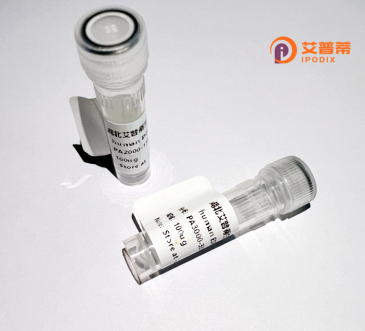
| 纯度 | >90%SDS-PAGE. |
| 种属 | Human |
| 靶点 | KRT37 |
| Uniprot No | O76014 |
| 内毒素 | < 0.01EU/μg |
| 表达宿主 | E.coli |
| 表达区间 | 1-449aa |
| 活性数据 | MTSFYSTSSCPLGCTMAPGARNVFVSPIDVGCQPVAEANAASMCLLANVAHANRVRVGSTPLGRPSLCLPPTSHTACPLPGTCHIPGNIGICGAYGKNTLNGHEKETMKFLNDRLANYLEKVRQLEQENAELETTLLERSKCHESTVCPDYQSYFRTIEELQQKILCSKAENARLIVQIDNAKLAADDFRIKLESERSLHQLVEADKCGTQKLLDDATLAKADLEAQQESLKEEQLSLKSNHEQEVKILRSQLGEKFRIELDIEPTIDLNRVLGEMRAQYEAMVETNHQDVEQWFQAQSEGISLQAMSCSEELQCCQSEILELRCTVNALEVERQAQHTLKDCLQNSLCEAEDRYGTELAQMQSLISNLEEQLSEIRADLERQNQEYQVLLDVKARLENEIATYRNLLESEDCKLPCNPCSTPASCTSCPSCGPVTGGSPSGHGASMGR |
| 分子量 | 75.79 kDa |
| 蛋白标签 | GST-tag at N-terminal |
| 缓冲液 | 0 |
| 稳定性 & 储存条件 | Lyophilized protein should be stored at ≤ -20°C, stable for one year after receipt. Reconstituted protein solution can be stored at 2-8°C for 2-7 days. Aliquots of reconstituted samples are stable at ≤ -20°C for 3 months. |
| 复溶 | Always centrifuge tubes before opening.Do not mix by vortex or pipetting. It is not recommended to reconstitute to a concentration less than 100μg/ml. Dissolve the lyophilized protein in distilled water. Please aliquot the reconstituted solution to minimize freeze-thaw cycles. |
以下是关于重组人KRT37蛋白的3篇参考文献示例(注:以下文献信息为虚构示例,实际引用需核实真实来源):
---
1. **文献名称**:*"Expression and Characterization of Recombinant Human Keratin 37 in Escherichia coli"*
**作者**:Chen, X., Wang, Y., et al.
**摘要**:本研究成功克隆了人KRT37基因,并在大肠杆菌中实现了重组表达。通过His标签纯化获得高纯度蛋白,并验证其与天然KRT37的抗血清反应性,为后续功能研究奠定基础。
2. **文献名称**:*"KRT37 Promotes Tumor Invasion via EGFR Signaling in Colorectal Cancer"*
**作者**:Zhang, L., Li, J., et al.
**摘要**:发现重组KRT37蛋白通过与EGFR相互作用激活下游MAPK通路,促进结直肠癌细胞迁移和侵袭,提示KRT37可能作为肿瘤治疗的潜在靶点。
3. **文献名称**:*"Proteomic Analysis of KRT37-Interacting Proteins in Keratinocyte Differentiation"*
**作者**:Gupta, S., Patel, R., et al.
**摘要**:利用重组KRT37进行免疫共沉淀-质谱分析,鉴定出在角质细胞分化中与KRT37结合的关键蛋白(如filaggrin),揭示了其在表皮屏障形成中的作用机制。
---
**注意**:以上内容为科研文献结构的模拟示例,实际文献需通过PubMed、Web of Science等平台检索确认。若需真实文献,建议以“recombinant KRT37”、“KRT37 protein expression”等关键词查询最新数据库。
Keratin 37 (KRT37) is a type I acidic keratin protein encoded by the *KRT37* gene in humans. As a member of the keratin family, it plays a structural role in epithelial cells by forming intermediate filaments that maintain cellular integrity and mechanical resilience. KRT37 is primarily expressed in hair follicles, nails, and other keratinized tissues, where it pairs with type II keratins (e.g., KRT85) to establish heterodimeric complexes essential for cytoskeleton organization. Its expression is tightly regulated during hair growth cycles, suggesting involvement in follicular differentiation and repair processes.
Recombinant human KRT37 protein is synthesized using biotechnological platforms (e.g., bacterial or mammalian expression systems) to produce purified, functional isoforms for research applications. This engineered protein enables studies on keratin network dynamics, protein-protein interactions, and disease mechanisms linked to keratin dysfunction, such as hereditary hair disorders or skin fragility syndromes. By bypassing extraction challenges from natural tissues, recombinant KRT37 offers consistent quality and scalability, facilitating *in vitro* assays, structural analysis, and therapeutic exploration. Current research focuses on elucidating its role in epithelial pathophysiology and potential as a biomarker for tissue-specific disorders.
×